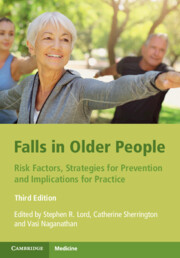Book contents
- Falls in Older People
- Falls in Older People
- Copyright page
- Contents
- Preface
- Contributors
- Part I Epidemiology and Risk Factors for Falls
- 1 Epidemiology of Falls and Fall-Related Injuries
- 2 Postural Stability and Falls
- 3 Gait Characteristics and Falls
- 4 Sensory and Neuromuscular Risk Factors for Falls
- 5 Biomechanics of Balance and Falling
- 6 Foot Problems, Footwear, and Falls
- 7 Brain Function and Falls
- 8 Impaired Cognition and Falls
- 9 The Psychology of Fall Risk: Fear, Anxiety, Depression, and Balance Confidence
- 10 Medical Risk Factors for Falls
- 11 Medications as Risk Factors for Falls
- 12 Environmental Risk Factors for Falls
- 13 Fall Detection and Risk Assessment with New Technologies
- 14 Fall Risk Screening and Assessment
- 15 The Relative Importance of Fall Risk Factors: Analysis and Summary
- Part II Strategies for Prevention
- Part III Implications for Practice
- Index
- References
7 - Brain Function and Falls
from Part I - Epidemiology and Risk Factors for Falls
Published online by Cambridge University Press: 04 November 2021
- Falls in Older People
- Falls in Older People
- Copyright page
- Contents
- Preface
- Contributors
- Part I Epidemiology and Risk Factors for Falls
- 1 Epidemiology of Falls and Fall-Related Injuries
- 2 Postural Stability and Falls
- 3 Gait Characteristics and Falls
- 4 Sensory and Neuromuscular Risk Factors for Falls
- 5 Biomechanics of Balance and Falling
- 6 Foot Problems, Footwear, and Falls
- 7 Brain Function and Falls
- 8 Impaired Cognition and Falls
- 9 The Psychology of Fall Risk: Fear, Anxiety, Depression, and Balance Confidence
- 10 Medical Risk Factors for Falls
- 11 Medications as Risk Factors for Falls
- 12 Environmental Risk Factors for Falls
- 13 Fall Detection and Risk Assessment with New Technologies
- 14 Fall Risk Screening and Assessment
- 15 The Relative Importance of Fall Risk Factors: Analysis and Summary
- Part II Strategies for Prevention
- Part III Implications for Practice
- Index
- References
Summary
Ageing is associated with a wide range of changes in the brain, including grey and white matter atrophy, as well as markers of small vessel disease such as white matter hyperintensities, microbleeds, and infarcts. Furthermore, beta-amyloid plaques and tau (the hallmarks of Alzheimer’s disease) are evident in the brain years before symptoms of dementia appear. A brain free of disease, with intact grey and white matter, is essential for the fast and efficient operation of the neural networks during daily life activities, and therefore also in reducing the risk of falling.
- Type
- Chapter
- Information
- Falls in Older PeopleRisk Factors, Strategies for Prevention and Implications for Practice, pp. 130 - 143Publisher: Cambridge University PressPrint publication year: 2021



